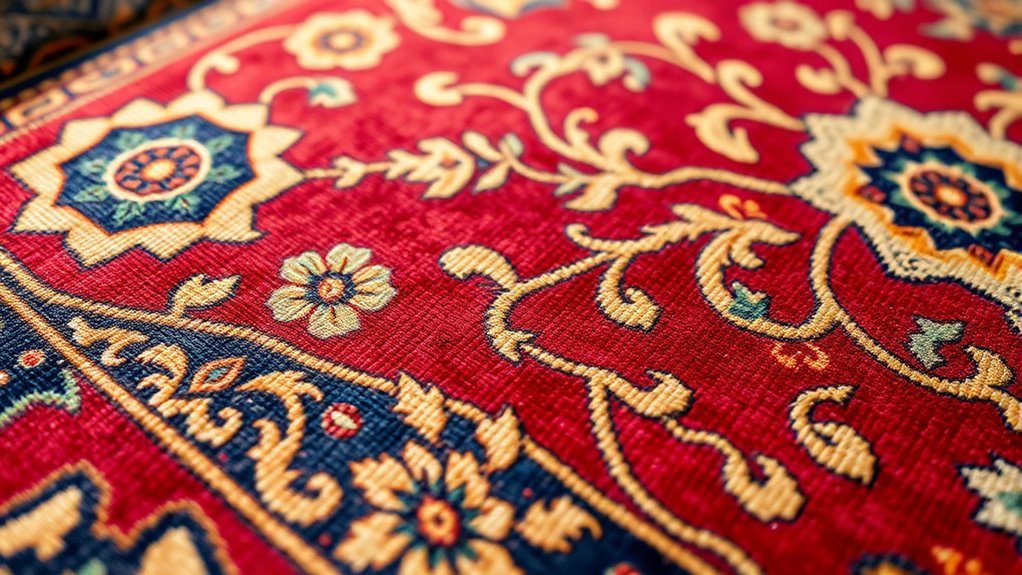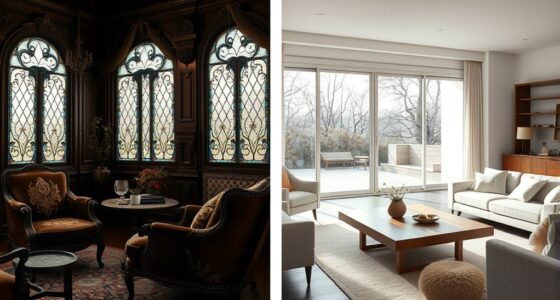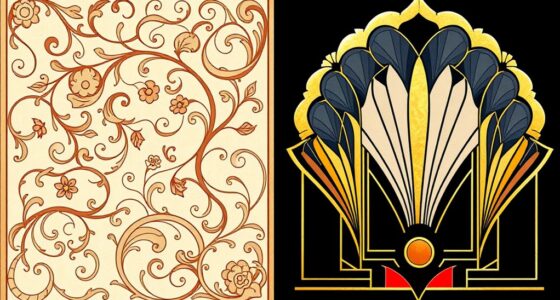Persian rug motifs stem from a long history rooted in dynastic symbolism, regional influences, and cultural exchanges. You’ll find patterns representing royal power, divine protection, and natural elements like flowers and trees, each with specific meanings. These designs evolved through different dynasties, reflecting changes in art and beliefs, and vary across regions. If you want to discover how these motifs tell stories of Persia’s rich history, keep exploring.
Key Takeaways
- Persian motifs originate from ancient dynastic symbolism, representing authority, divine protection, and cultural values.
- Motifs are influenced by regional landscapes, resources, and local traditions, creating diverse design styles.
- Historical periods like the Achaemenid, Safavid, and Qajar dynasties introduced evolving symbolic elements.
- Geometric patterns symbolize eternity and unity, while floral motifs represent paradise, renewal, and fertility.
- Contemporary designs reinterpret traditional motifs, blending historical symbolism with modern aesthetics.
Historical Roots of Persian Artistic Traditions
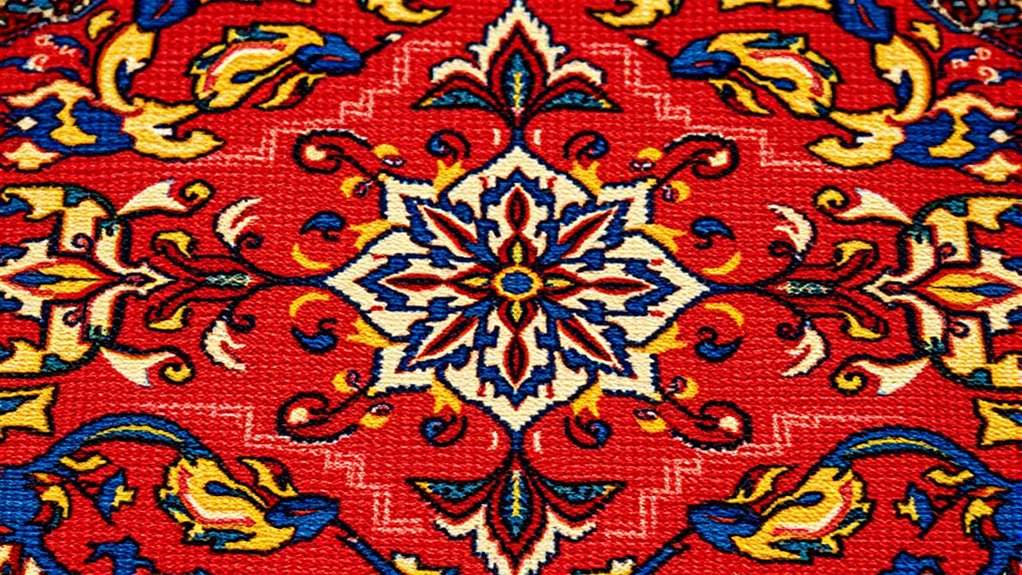
The rich artistic traditions of Persia have deep roots that stretch back thousands of years. You’ll notice how dynastic symbolism plays a key role in shaping Persian rugs, reflecting the power and beliefs of ruling dynasties. These motifs often symbolize royal authority, divine protection, or cultural values, creating a visual language passed through generations. Artistic exchanges between Persia and neighboring regions fostered the development of unique styles, blending motifs and techniques across cultures. These interactions enriched Persian textile art, allowing motifs to evolve while maintaining their symbolic significance. Additionally, the cultural exchange during different historical periods introduced new stylistic influences that continue to inspire contemporary designs. By understanding these historical influences, you gain insight into how Persian rugs serve as more than decorative items—they’re woven stories of dynastic pride, cultural exchange, and centuries of artistic innovation.
Symbolism and Meaning Behind Common Motifs
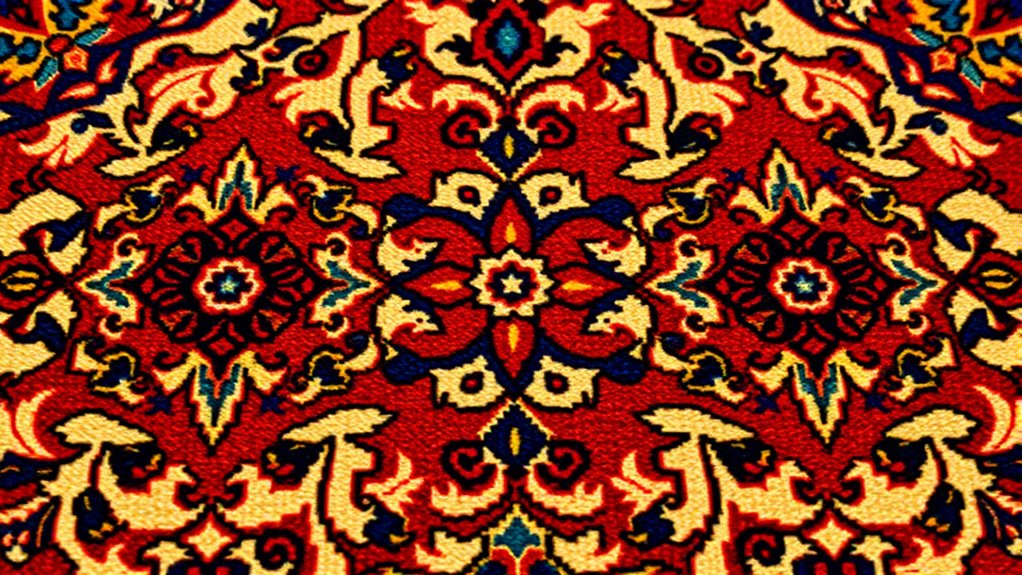
As you explore Persian rugs, you’ll notice that each motif carries a specific meaning rooted in cultural and spiritual beliefs. These symbols often reflect hopes, protection, or blessings. Geometric patterns, for example, may symbolize eternity or unity, with repeating shapes representing life’s cyclical nature. Floral symbols often stand for paradise, renewal, or fertility, conveying a sense of growth and harmony. You might see a stylized lotus or a stylized tree, each carrying deeper significance. These motifs aren’t just decorative—they embody stories, beliefs, and traditions passed down through generations. Recognizing these symbols enriches your understanding of Persian art, allowing you to appreciate the craftsmanship beyond its visual appeal. Every pattern is a meaningful expression of cultural identity and spiritual aspirations. Additionally, understanding the AI security challenges associated with digital preservation can help protect these cultural artifacts in the modern era.
Regional Variations and Influences on Design
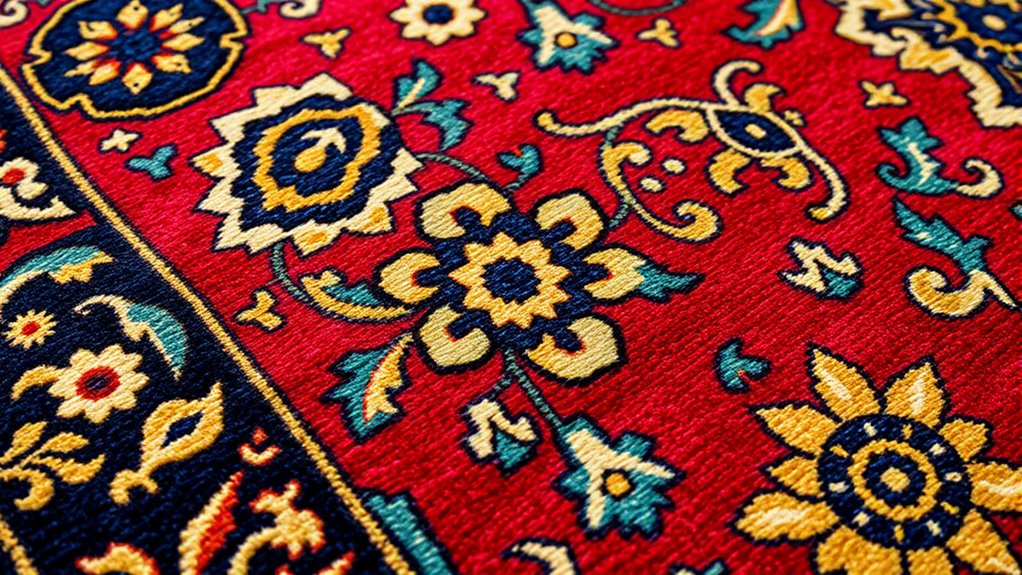
Regional factors profoundly shape Persian rug designs, reflecting local landscapes, resources, and cultural influences. You’ll notice tribal patterns unique to each area, showcasing distinct styles and stories. Regional palettes vary, evoking different emotions and atmospheres. For example, bold reds and blues might dominate in one region, while softer earth tones appear elsewhere. These variations create a tapestry of diversity, making each rug a personal reflection of its origin. Additionally, design consistency within regions often highlights shared traditions and craftsmanship passed down through generations.
The Evolution of Motifs Through Persian Dynasties
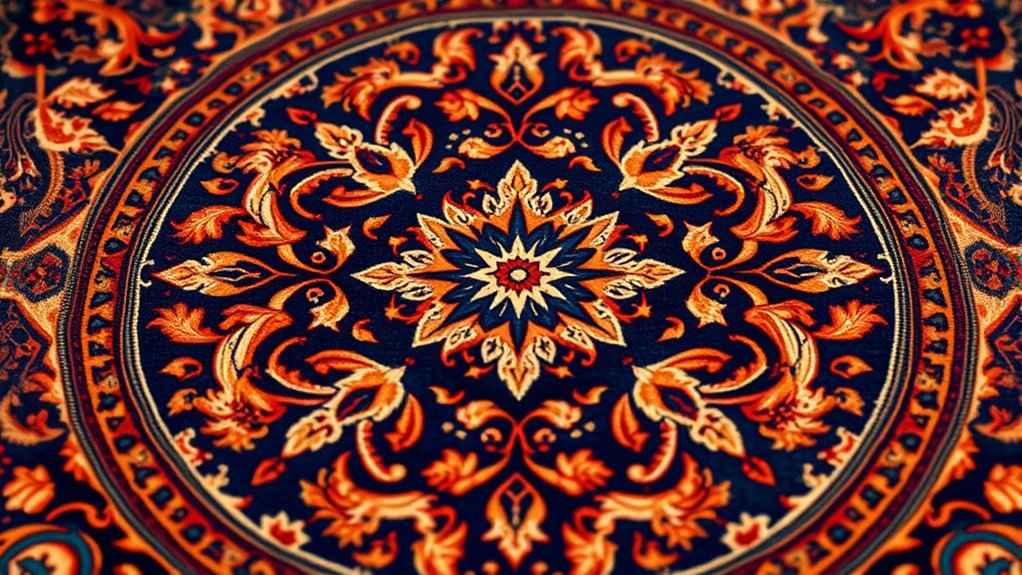
Throughout Persian history, dynasties have played a crucial role in shaping the motifs found in rugs, with each era introducing new styles and symbolic elements. You can observe how dynastic influences drive motif evolution, reflecting political, cultural, and religious shifts. During the Achaemenid period, motifs emphasized grandeur and power, featuring mythological creatures and regal symbols. The Safavid dynasty brought a renaissance of floral patterns and intricate arabesques, blending Persian artistry with Islamic aesthetics. Later, the Qajar era introduced more stylized and symbolic motifs, often depicting national identity and historical themes. These changes highlight how each dynasty’s unique preferences and influences transform traditional motifs into evolving artistic expressions. Additionally, the incorporation of symbolic motifs demonstrates how cultural and religious beliefs are embedded into rug designs over time.
Contemporary Interpretations and Reinterpretations
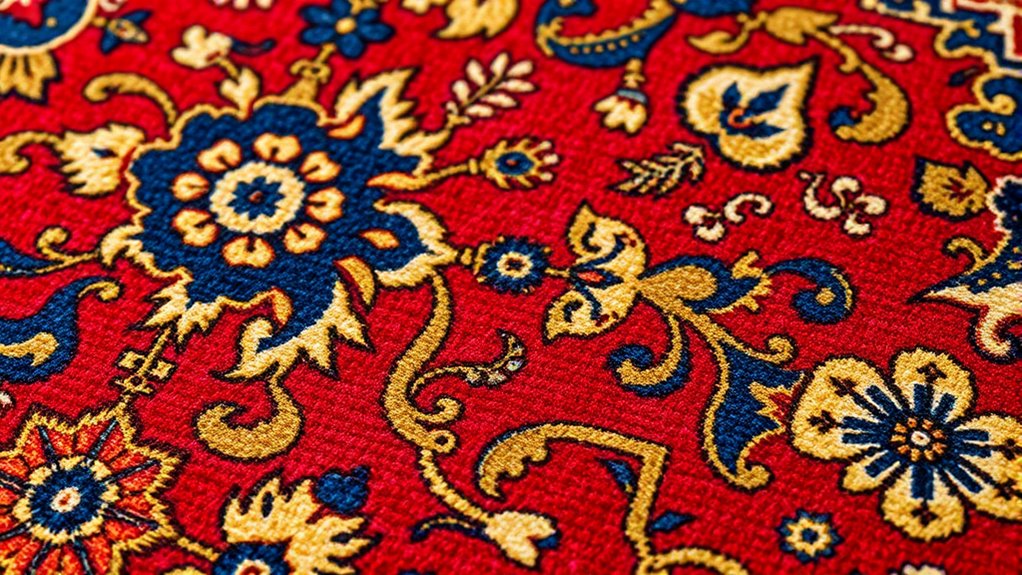
Contemporary artisans and designers reinterpret Persian motifs by blending traditional symbols with modern aesthetics and themes. These modern adaptations often incorporate minimalist lines, bold colors, and innovative patterns, giving ancient designs fresh relevance. They also embrace cultural revivals, celebrating Persian heritage in new ways that appeal to today’s audiences. By reimagining classic motifs, artists create rugs that honor history while reflecting current trends. This process highlights the importance of cultural preservation in maintaining the significance of traditional art forms. Such reinterpretations not only preserve Persian motifs but also expand their influence, making them more accessible and meaningful in contemporary interior design. Ultimately, these efforts ensure that Persian rug artistry remains vibrant and relevant, continuously evolving with cultural shifts and artistic creativity.
Frequently Asked Questions
How Do Trade Routes Influence Persian Rug Motifs?
Trade route influences shape Persian rug motifs by introducing new design elements and symbolism. As you observe, traders carry ideas and cultural symbols along routes like the Silk Road, blending diverse artistic influences into rug patterns. These motifs often symbolize protection, fertility, or spirituality, reflecting the exchange of beliefs and traditions. So, your Persian rug’s motifs tell a story of trade, cultural interaction, and shared symbolism across regions.
What Materials Were Traditionally Used in Persian Rug Weaving?
You’ll find that traditional Persian rugs are crafted with natural materials like wool, silk, and cotton, each adding a unique thread to their story. Skilled artisans use dyeing techniques derived from plants and minerals, creating vibrant colors that breathe life into their designs. Knotting styles such as the Persian (Senneh) and Turkish knots weave these materials into intricate patterns, making each rug a tapestry of history and craftsmanship.
Are Specific Motifs Linked to Particular Persian Tribes?
Yes, specific motifs are linked to particular Persian tribes, reflecting their tribal symbolism and cultural identity. When you examine a rug, you’ll notice certain motifs that signify the tribe’s history, beliefs, or social status. These symbols serve as a visual language, making the tribal symbolism clear. Recognizing these motifs helps you understand the rich cultural heritage behind each rug, emphasizing the importance of tradition and identity in Persian weaving.
How Do Modern Artists Reinterpret Traditional Persian Motifs?
You see modern artists reinterpreting traditional Persian motifs by blending cultural symbolism with contemporary interpretations. They incorporate vivid colors, abstract forms, and new materials to breathe fresh life into classic designs. This approach allows them to honor Persian heritage while making the motifs relevant today. Through innovative techniques, they create pieces that connect past and present, inviting viewers to explore the rich cultural symbolism embedded in each artwork.
What Role Do Religious Beliefs Play in Motif Selection?
You see that a prayer rug’s motifs often reflect religious symbolism, like the mihrab indicating the direction of Mecca. Religious beliefs influence motif selection by imbuing designs with symbolic meanings, such as the lotus representing purity or the cypress tree symbolizing eternity. These motifs serve as visual expressions of faith, guiding and inspiring worshippers through their intricate patterns rooted in spiritual significance.
Conclusion
As you explore Persian rugs, imagine walking through ancient bazaars where vibrant motifs whisper stories of history and culture. Each design, whether a blooming flower or intricate medallion, invites you into a world woven with symbolism and artistry passed down through generations. These timeless patterns dance across the fabric, bridging past and present. By appreciating their origins, you connect with a rich tapestry of tradition that continues to inspire and captivate your senses.

